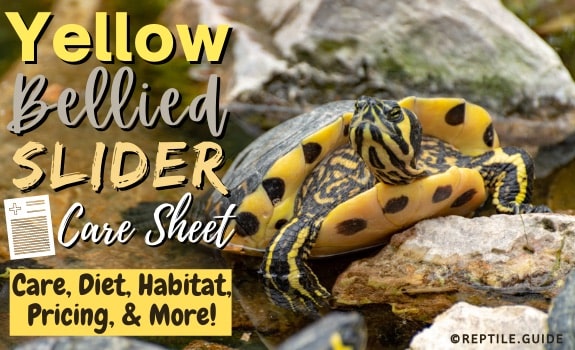Yellow-Bellied Sliders are one of the most common aquatic pet turtles – after Red-Eared Sliders (opens in new tab), of course.
These closely related pond turtles have a very similar appearance and identical care requirements, so if you’re familiar with one, you should be good to go with the other!
If you’re new to turtles and you prefer something a little different or favor yellow markings over red markings, this species could easily be your perfect fit.
Keep reading to find out how to care for these entertaining little pets!
In This Article
Species Summary
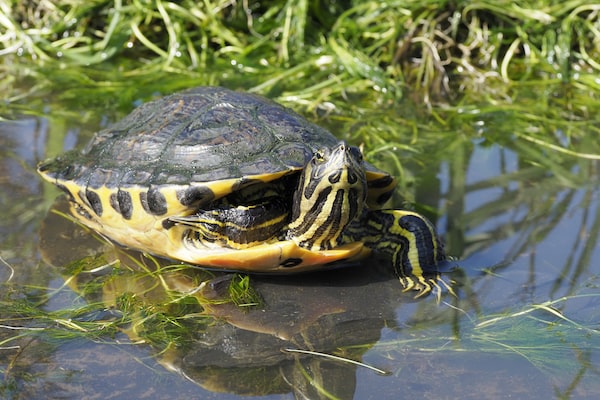
Yellow-Bellied Sliders are a pond turtle species native to the Southeastern United States, from Florida to Virginia.
It’s the MOST common turtle species in its range, and it often interbreeds with invasive Red-Eared Sliders.
Yellow-Bellied Sliders prefer to live in rivers, swamps, wetlands, and ponds that are slow-moving and deep. They show an affinity towards habitats with an abundance of algae and water surface plants, which offer them cover from predators.
While those are the habitats they prefer, you can usually find them in almost any type of water source, in any setting.
Their adaptability is what makes them such great pets that can endure the mild husbandry mistakes of a beginner or even live in a backyard pond!
Wild turtles typically eat first thing in the morning, then spend the afternoon and early evening basking and digesting their food.
Research findings have shown that a Yellow-Bellied Slider’s diet changed with age; Hatchlings are carnivorous, while adults’ diets consist of up to 95% aquatic plants.
Appearance & Colors
Yellow-bellied sliders mostly resemble their closely-related pond turtle cousins, like the red-eared slider.
One key difference is their namesake yellow, spotted plastron, or belly shell. The belly markings are black or dark green and help differentiate this species from the almost-identical eastern river cooters.
Yellow-bellied sliders also have yellow stripes extending down their legs and neck.
A healthy, intact shell or “carapace” on an adult Yellow-Bellied Slider is smooth and dark brown or black. Young Yellow-Bellied Sliders have intricate golden lines on their shells, but these fade with age.
However, it should be noted that scholars believe genetic differentiation does exist due primarily to differences in habitat.
⭐️ Fun Fact: Researchers have found that the shells of turtles, in particular yellow-bellied sliders, become increasingly asymmetrical as they age. This is especially prevalent with male turtles.
Yellow-Bellied Slider Size
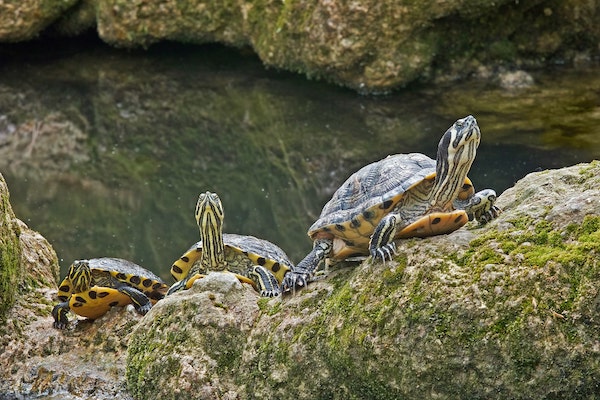
As with most aquatic turtle species, Yellow-Bellied Sliders demonstrate sexual dimorphism.
Mature females are considerably larger than adult males.
Hatchling Yellow-Bellied Sliders emerge from their eggs at a mere 1 inch long and reach around 4 inches by their first birthday.
After that, they only grow about 1 inch per year until they get to their adult size. They will continue to grow throughout their lives, but the growth slows considerably after attaining adult size.
Adult Male Length: 5-9 Inches
Adult Female Length: 8-13 Inches
Lifespan
Yellow-Bellied Sliders live for a LONG time, just like most other chelonians (turtles and tortoises)!
Still, when compared to tortoises that are thought to live over 100 years, the Yellow-Bellied Slider may not seem as intimidating in terms of commitment.
Healthy, captive Yellow-Bellied Sliders usually live for about 40 years.
Males can reach sexual maturity in as little as 2 years, while females may take 8 years before they’re ready to lay eggs!
Yellow-Bellied Slider Care
Enclosure Size & Dimensions
Yellow-bellied sliders are considered medium to large-sized turtles, so even the smallest adult will require a 55-gallon aquarium.
When choosing an aquarium for pond turtles, the general rule of thumb is to get an aquarium with at least 10 gallons per inch of turtle. For example, a 10-inch adult female Yellow-Bellied Slider would require a 100-gallon aquarium, or even bigger, if you have space.
Many crafty turtle keepers have also devised ways to utilize troughs, stock tanks, pond liners, and plastic storage tubs as makeshift turtle enclosures!
These are typically much more affordable than glass or acrylic aquariums of similar dimensions and may even allow you to offer even more swimming space to your turtle.
Since wild Yellow-Bellied Sliders inhabit and dive in deep ponds and rivers, keep the water at least 12 inches deep, or even 18 inches deep for large females.
Habitat Setup
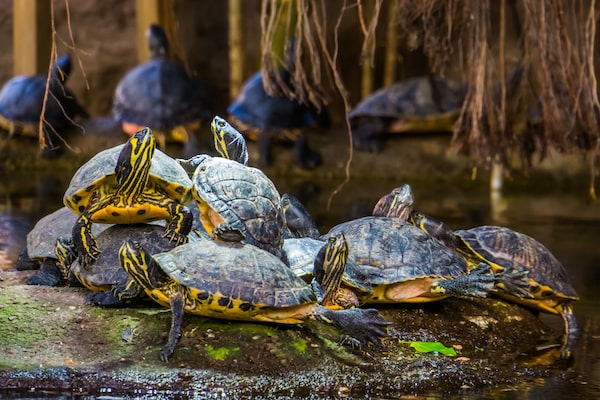
Yellow-Bellied Sliders are primarily aquatic, so while conventional aquariums work perfectly fine as enclosures, your turtle WILL require a haul-out area to warm up and dry off periodically.
Many commercially available turtle basking docks are available, and they make installation simple.
Again, crafty turtle keepers have devised multiple DIY turtle basking areas that are cheaper and more functional than their pet store counterparts. The biggest drawback is that these DIY plans usually aren’t as visually appealing.
PVC, wood, plastic mesh, natural driftwood logs, and clean rocks are viable options when crafting a homemade basking spot for your Yellow-Bellied Slider.
Yellow-Bellied Sliders are very active and curious turtles, so they will appreciate aquarium decor like driftwood, statues, live or fake plants, large river rocks, and artificial caves.
Substrate will also spruce up your aquarium’s appearance and enrich your turtle’s habitat, but choose carefully.
Standard aquarium gravel poses a genuine impaction risk if your turtle accidentally ingests it, which does happen most of the time with this ravenous species!
Most turtle keepers stick with river rocks, washed play sand, or leave the bottom of the aquarium bare.
Bare-bottom aquariums are the easiest to maintain and keep clean, and they pose absolutely NO risk to your turtle.
Large river rocks are safe but create many cracks and crevices for uneaten food to get lost in. You will need to siphon those areas often and well to prevent old food from rotting and fouling the water.
Play sand is also generally considered safe, as long as you rinse it until the water runs clear before adding it to your aquarium.
Unfortunately, you will need to take measures to prevent your filter from siphoning up the sand particles or risk the motor dying prematurely.
Keep the depth of the sand substrate under 2″ to avoid a build-up of dangerous bacteria.
Temperature & Lighting
Yellow-Bellied Sliders that are kept indoors require supplemental heat and light.
Heat is required for digestion, and you’ll need to heat the aquarium water and the basking spot separately.
Standard aquarium heaters work well for heating the water. To heat the basking spot, you can use a ceramic heat emitter or a halogen lightbulb.
Turtles also require specialized UV-emitting lightbulbs to synthesize Vitamin D3, which is needed to absorb and utilize calcium.
The standard source for UV lighting is a compact fluorescent or tube fluorescent lightbulb.
Always follow the manufacturer’s instructions when setting up the light fixture and basking area. Specific distance guidelines need to be followed for an optimal UV index.
UV lightbulbs need to replaced every 6 to 12 months. Even though they continue to produce visible light, the quantity and quality of the UV light that they make declines with usage.
Ideal Water Temperature: 75-80°F
Ideal Basking Spot Temperature: 80-90°F
UVB Light Duration: 12 Hours On/12 Hours Off
Water Quality
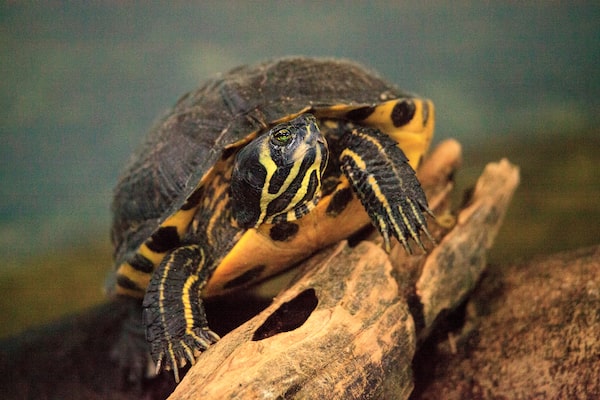
When it comes to water quality and maintenance, keeping Yellow-Bellied Sliders is actually more like keeping fish than keeping reptiles!
Since Yellow-Bellied Sliders spend the majority of their time wholly or partially submerged in their water, they are exposed to ALL of the pollutants, bacteria, and fungus that may be in the water.
Water Filtration
Aside from UV lighting, water filtration may be one of the MOST critical aspects of aquatic turtle ownership.
Poor water quality can lead to shell rot, eye infections, ammonia burns, and more.
Most standard aquarium filters are suitable for use in your turtle’s aquarium. The style of filter that most turtle keepers prefer is a canister filter.
Regardless of what type of filter you decide on, be sure that it’s rated for an aquarium 2-3x the size of the aquarium you’re using.
Yellow-Bellied Sliders produce a lot more waste than fish.
Most aquarium filters, including canister filters, use biological filtration, chemical filtration, and mechanical filtration.
Mechanical filtration involves the use of filter floss or sponges that trap large particles of waste and food to remove them from the water.
Mechanical filter media should be periodically swished through a bucket of used aquarium water to remove large particles.
Biological filtration involves the growth of beneficial bacteria that consume ammonia and nitrites, which are harmful and detrimental to your turtle’s health.
These bacteria usually grow inside of the aquarium filter, especially on mechanical filter media, which is why it’s essential to wash your filter gently and with aquarium water only.
Tap water and excessive force will kill the beneficial bacteria.
Chemical filtration involves the use of activated carbon to remove impurities and pollutants from the water that can’t be handled by mechanical or biological filtration.
Activated carbon cartridges need to be replaced every 14-31 days, or they will re-release harmful compounds into the water.
In addition to using a water filter, you should remove 15-25% of the enclosure water every week. Replace it with cold tap water that is free of chlorine and chloramine.
Water Conditioning
To remove chlorine and chloramine from tap water, you’ll need to use an aquarium water conditioner.
If you don’t use an aquarium water conditioner, these chemical compounds that are used to purify tap water will prevent the growth of beneficial bacteria and irritate your Yellow-Bellied Slider’s eyes, mouth, nostrils, and cloaca.
Some water conditioners even neutralize nitrites and ammonia.
Always read the packaging material for dosing instructions.
Water Temperature
As discussed above, you’ll NEED to use an aquarium water heater for your Yellow-Bellied Slider. Room temperature water is too cold for year-round conditions.
Many aquarium heaters don’t come with a reliable thermostat and are, instead, pre-set to warm the water up to 78°F.
This is a suitable temperature for your pet turtle, but you may wish to purchase a water heater with a built-in, programmable thermostat.
NEVER allow the aquarium water heater to run outside of water. It will become too hot and break.
Food & Diet
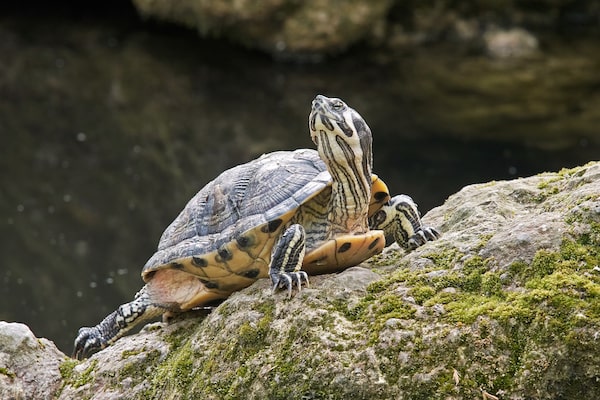
Hatchling Yellow-Bellied Sliders prefer a diet that is higher in protein (and calcium) to sustain the rapid growth they experience in the first few years.
Meanwhile, adult male Yellow-Bellied Sliders remain significantly carnivorous, but adult females gradually become herbivorous as they mature.
Most commercial aquatic turtle diets contain acceptable amounts of protein and vitamins to be used as the primary diet for a turtle of any age.
For growing babies and juveniles, feed an amount of food that would fit inside their head (if it was hollow) daily.
Supplement turtle pellets with shrimp, insects, earthworms, and steamed fish or chicken to increase their dietary protein.
For fully-grown adults, feed an amount that would fit inside your turtle’s hollow head every other day.
You can offer high-protein snacks to adults a maximum of once per week.
Since Yellow-Bellied Sliders are natural foragers, they will always be rooting around for more food.
It’s recommended to allow a large, leafy green to float in the aquarium at all times, so your turtle can graze to its heart’s content.
Floating chunks of cuttlebone, with the sharp edges removed, are also relished by many Yellow-Bellied Sliders, and they’re a GREAT source of extra calcium.
Be sure to offer your slider a balanced diet of vegetables, fresh fruits, live prey, turtle pellets, and supplements.
Remember, some fruits—like strawberries—can serve as enjoyable treats for your slider.
But they should not become the staple food because they won’t be able to meet all of your turtle’s nutritional needs.
Potential Health Issues
While Yellow-Bellied Sliders are considered a very hardy species that are forgiving and tolerant of husbandry errors, they DO have requirements that should be met.
While they can survive suboptimal conditions for a short period, improper lighting, hygiene, or diet will inevitably lead to illness in your turtle.
Shell Pyramiding
Cause: Malnutrition, excessive dietary protein
Symptoms: Shell scutes begin to take on the shape of a pyramid
Treatment: Feed a species-appropriate diet, which is mostly plant-based for adult Yellow-Bellied Sliders. The shell will always be deformed, but it shouldn’t impact your turtle’s health or life once the diet is resolved.
Vitamin A Deficiency
Cause: Improper diet (iceberg lettuce, excessive meat, low quality or stale commercial pellets)
Symptoms: Lethargy, lack of appetite, weight loss, swollen eyes, mucous discharge from the nose or mouth, secondary infections
Treatment: Feed a balanced, Vitamin A-rich diet (pellets, dark leafy greens, yellow and orange vegetables, whole fish, liver). Severe cases may require oral or injectable vitamin A supplementation until proper vitamin levels are achieved.
Metabolic Bone Disease
Cause: Malnutrition (calcium deficiency), lack of proper UV lighting
Symptoms: Soft shell, broken bones, bowed legs, tremors, weakness
Treatment: Supplement feeder insects and boneless meat with calcium powder, feed a commercial turtle diet, set up proper UV lighting. Severe cases may require oral or injectable calcium supplementation until acceptable vitamin levels are achieved.
Respiratory Infection
Cause: Unsanitary enclosure or poor filtration, stress, cold temperatures, vitamin A deficiency
Symptoms: Mucus discharge or bubbles from nose or mouth, lethargy, lack of appetite, wheezing, extending the neck to breathe, open-mouth breathing
Treatment: Antibiotics
Shell Rot
Cause: Unsanitary enclosure, secondary to trauma, burns, or bites
Symptoms: Red or slimy fluid on the shell, soft shell, flaking plates, foul odor, lesions
Treatment: Isolating the turtle in a dry treatment enclosure, cleanse the lesions with an antiseptic daily, antibiotics may be required for severe cases
Abscess
Cause: Unsanitary enclosure, vitamin A deficiency
Symptoms: Hard lumps or bumps on your turtle’s skin, especially behind their eye
Treatment: Surgery and antibiotics
Pneumonia
Cause: Unresolved respiratory infection
Symptoms: Lopsided swimming, lack of appetite, lethargy, disoriented movements
Treatment: Antibiotics
Sepsis
Cause: Unresolved infection
Symptoms: Unresponsive, lack of appetite, lethargy, pink or red tinge to skin and shell
Treatment: Emergency veterinary treatment
Behavior & Temperament
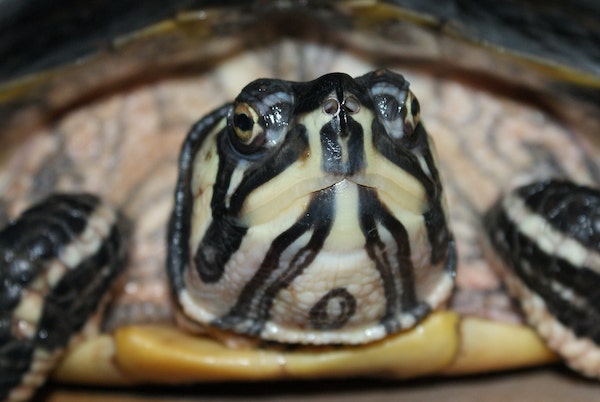
Yellow-Bellied Sliders are active, curious animals that enjoy basking and exploring their aquarium during the day.
They LOVE to eat and often beg for food or treats. Some turtle owners have even taught their slider to perform basic tricks or behaviors.
Once your Yellow-Bellied Slider is used to your presence and associates you with food, it will most likely begin to follow you from inside of its enclosure while you move around the room where it can see you.
When it comes to other turtles, Yellow-Bellied Sliders are pushy and territorial, so they SHOULDN’T be housed with any other turtles.
You can house feeder fish in their aquarium to encourage exercise and enrichment BUT be prepared for those fish to go “missing”…
Handling Them
Yellow-Bellied Sliders don’t usually enjoy being handled. They should be left in their enclosure, where they feel comfortable.
Threatened sliders will either withdraw into their shell OR bite!
A neat way to interact with your Yellow-Bellied Slider without force-handling is to hand-feed treats.
Conclusion
Yellow-Bellied Sliders make engaging, interactive, and relatively easy to care for pets as long as their keeper has a basic understanding of the species’ care requirements.
If you’ve made it this far, you’re already there – congratulations!
Equipped with the knowledge of proper lighting, heating, and water quality, you’re all set to be the fantastic owner of a lucky Yellow-Bellied Slider.
